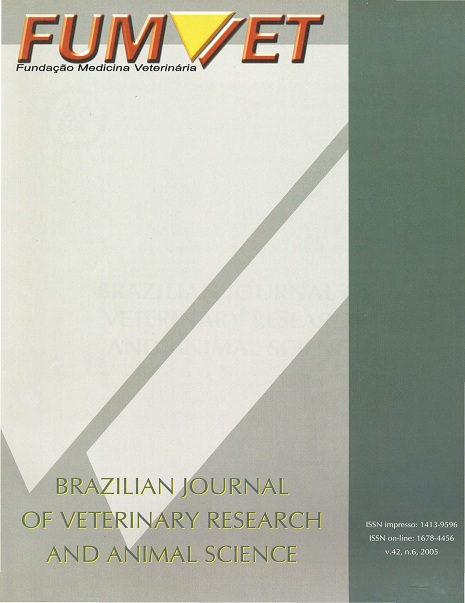Identification of fungi microflora in the ear conducts of rhesus macaques (Macaca mulatta) kept in captivity: uma abordagem estereológica
DOI:
https://doi.org/10.11606/issn.1678-4456.bjvras.2005.26405Keywords:
Fungi microflora, Non-human primates, Rhesus monkey, Ear conductAbstract
Several predisposing factors could lead to auricular diseases caused by a saprophytic microflora. Identification of the microflora of fungi could help in the diagnosis and treatment of mycoses that can become pathogenic in case of homeostasic unbalance. This report aimed to identify the saprophytic fungi microflora in the middle ear conduct of clinically healthy rhesus monkeys used for biomedical research. Forty rhesus macaques were divided into two groups. Group I was formed by adult animals, housed in individual cages inside special experimentation containers with controlled temperature and humidity. Group II, originated from the colony, was formed by young animals, which were maintained in the natural environment, without temperature and humidity control. Cerumen of the middle ear conduct of the animals was collected through swabs. Cultivation of the samples was performed in Petri plates with Sabouraud agar with cloramphenicol 1%, sealed with adhesive tape and incubated at room temperature. In the 20 animals from group I, we found the following: Aspergillus (80%), Candida (60%), Cladosporium (5%) and Rhodotorula (5%). Group II presented a major diversity of fungi: Candida sp. (95%), Aspergillus (20%), Cladosporium sp. (60%), Penicillium sp. (30%), Rodotorulla sp. (15%), Trychophytum verrucosum (5%), Epidermophyton flocosum (5%), and Scopulariopsis sp. (5%). These data will be useful for diagnoses and treatments of otites and suggest that climatic factors could be responsibles for the great number of fungi present in the animals from group II, which were exposed to natural climatic conditions.Downloads
Download data is not yet available.
Downloads
Published
2005-12-01
Issue
Section
UNDEFINIED
License
The journal content is authorized under the Creative Commons BY-NC-SA license (summary of the license: https://
How to Cite
1.
Brotto TL, Andrade MCR, Gonçalves M Ângelo B, Gimenis F, Pina A. Identification of fungi microflora in the ear conducts of rhesus macaques (Macaca mulatta) kept in captivity: uma abordagem estereológica. Braz. J. Vet. Res. Anim. Sci. [Internet]. 2005 Dec. 1 [cited 2024 Apr. 16];42(6):459-64. Available from: https://revistas.usp.br/bjvras/article/view/26405





